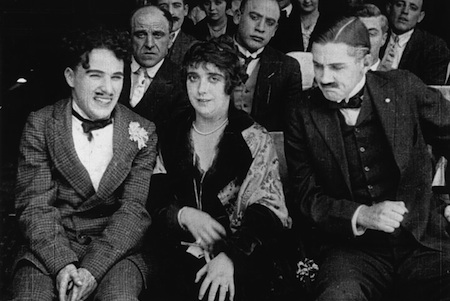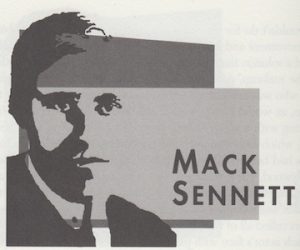Born: January 17, 1880, Danville, Quebec, Canada
Died: November 5, 1960, Hollywood, CA
He that is without humor among you, let him cast the first pie.
—Mabel Normand
Mack Sennett’s ambition to become an opera star never got further than the circuses and burlesque theaters he performed in at the turn of the century. Joining Biograph studios in 1909 as an actor and scriptwriter, he picked up directing and editing tips from D.W. Griffith. He left three years later to start a venture in Los Angeles that would become a beacon for clowns, barnstormers, roustabouts, prizefighters, mimes, acrobats, vaudevillians and rodeo riders. His studio was known as a laboratory for the wildest experiments in pratfalls, stunts and comedic sight gags, and he received a special Oscar in 1937 for lasting contributions to the slapstick comedy genre. Often overlooked is the sheer volume of films that Sennett churned out in an effort to satisfy the hungry, volatile film industry in its fragile infancy.
As the owner of the Keystone Company, Sennett recognized the demand for a constant, entertaining stream of short films to round out the movie bill at theaters across the country. To accomplish this, his assembly-line method produced nearly one film a day without benefit of scripts or preparation. He created a breakneck formula for making low-budget variations on the same two themes—sex and violence. Sennett’s Bathing Beauties were only slightly less famous than his ingenious group of comedians gathered together as the Keystone Kops. Throughout the 1920s, no other troupe came to characterize silent comedy better.
Through happenstance, Sennett comedies developed a distinct style: devoid of logic, full of anarchy, completely over the top. Utilizing the latest camera tricks and high-speed techniques, Keystone hijinks centered around the chase; incompetent officers in baggy uniforms dashed off cliffs, swung around corners and never slowed down. Often Sennett would rush to an automobile accident or building fire with equipment in tow and have his actors improvise on the spot. When the fledgling Charlie Chaplin arrived just one year into Keystone’s success, Sennett explained the key to his profitable output by saying, “We have no scenarios. We get an idea, then we follow the natural sequence of events until it leads to a chase, which is the essence of our comedy.”
The corner of 8th Street and Figueroa in Los Angeles became a favorite Kops intersection, where Sennett would spill liquid soap on the street to aid with the hijinks. Needless to say, safety wasn’t a main concern; Sennett encouraged the gratuitous use of bricks, plaster of paris bottles and, of course, an ample supply of cream pies (a delicious addition incorporated by Fatty Arbuckle). He employed engineers to build special wind machines, intricate plumbing works, electrical apparatus, trick cars and whatever could be swung from piano wires. He also collected a menagerie of animals to throw into the comic mix: horses great Danes, elephants, giraffes, lions and dogs trained to smoke and drink.
The feverish demand for Sennett comedies cannot be understated. His Keystone shorts were shipped all over the world, so quickly that often no attempt was made to retrieve prints before the next shipment. Sometimes he would have his directors simultaneously film with four separate cameras, then simply send negative stock directly to international destinations rather than taking the time to duplicate prints.
A paranoid and argumentative leader, Sennett rode roughshod over everyone. He didn’t care too much for writers, and his feelings for a particular actor or comedian would vary from week to week, but the success that prompted Sennett to anoint himself “the king of comedy” would also give rise to other royalty. Besides Chaplin, his talent searches yielded such incredible talent as Fatty Arbuckle, Harold Lloyd, Gloria Swanson, Ben Turpin, Chester Conklin, W.C. Fields and Bing Crosby. To help him direct more than a thousand one- and two-reel comedy shorts, Sennett hired Frank Capra and George Stevens, among other talented directors.
In 1914, Sennett’s company produced the first American feature-length comedy, Tillie’s Punctured Romance. Such successes as His Bitter Pill (1916) and The Shriek of Araby (1923) followed before the introduction of double features and animated cartoons signaled the end of Keystone shorts. The stock market crash of 1929 cleaned out Sennett’s bankroll, and he retired broke in 1935. Still, the real riches of the Sennett system remain in film vaults today. His studio produced nearly every comic invention ever recorded on film.





